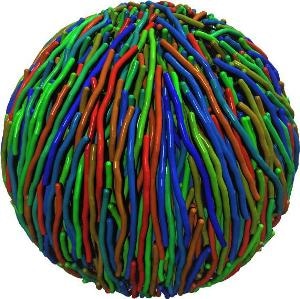Jul 27 2017
A team of Theoretical Physicists headed by Professor Kurt Binder and Dr. Arash Nikoubashman from the Johannes Gutenberg University Mainz (JGU) have adopted computer simulations to investigate the positioning of stiff polymers inside spherical cavities.
The role played by such confined systems in a broad array of applications—for example, synthesizing nanoparticles for targeted delivery of drugs and for customized nanomaterials—is highly significant. In addition, the systems analyzed can provide valuable understanding of internal functioning of biological challenges in which confinement effects are highly critical, including self-arrangement of actin filaments in cells and packaging of double-stranded DNA inside bacteriophage capsids.
 Bipolar structure assembled of stiff polymers at low densities. (©: Arash Nikoubashman, Mainz University)
Bipolar structure assembled of stiff polymers at low densities. (©: Arash Nikoubashman, Mainz University)
The simulations indicate that completely flexible chains are uniformly dispersed inside the spherical cavity, where an unstructured surface is formed at the confining sphere. Yet, upon increasing the stiffness of the chains, the polymers got lined up in a parallel manner, where the ends of the chains are arranged along a common equatorial plane. Complex structures simultaneously appeared on the surface of the sphere.
The chains gave rise to bipolar patterns, similar to those of globes and onions, at average stiffness and lower densities. Upon increasing the stiffness and density, the texture was modified to a structure resembling a tennis ball, including four distinguishable poles.
Such largely uncommon states emerge as a result of the complex coaction of bending and packing of the discrete polymer chains. Although it is entropically conducive for stiff polymer chains to get lined up parallel to one another, the spherical confinement prevents this arrangement along the entire system, thus making the chains near the surface of the sphere have to bend, which is an energetically adverse phenomenon.
In fact, such a nematic phase is highly significant for the operational nature of liquid crystal displays. The ensuing structures assist in overcoming these constraints.
The simulations offered the initial chances for detecting and analyzing the self-arrangement of stiff polymers inside spherical cavities. The colleagues of Dr. Arash Nikoubashman and Professor Kurt Binder strongly believe that their study could assist in deciphering the conduct of not only synthetic but also naturally existing soft systems under confinement.